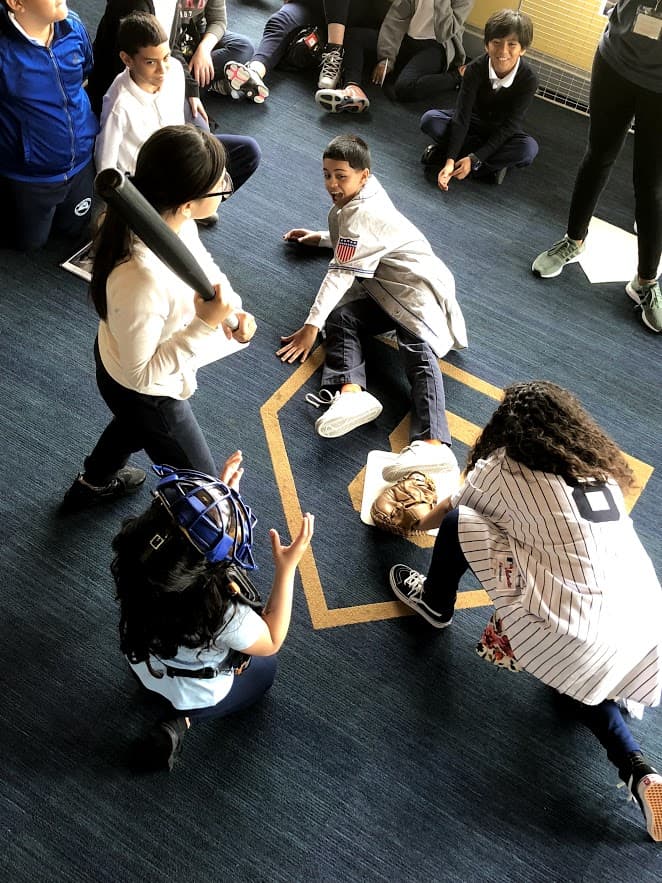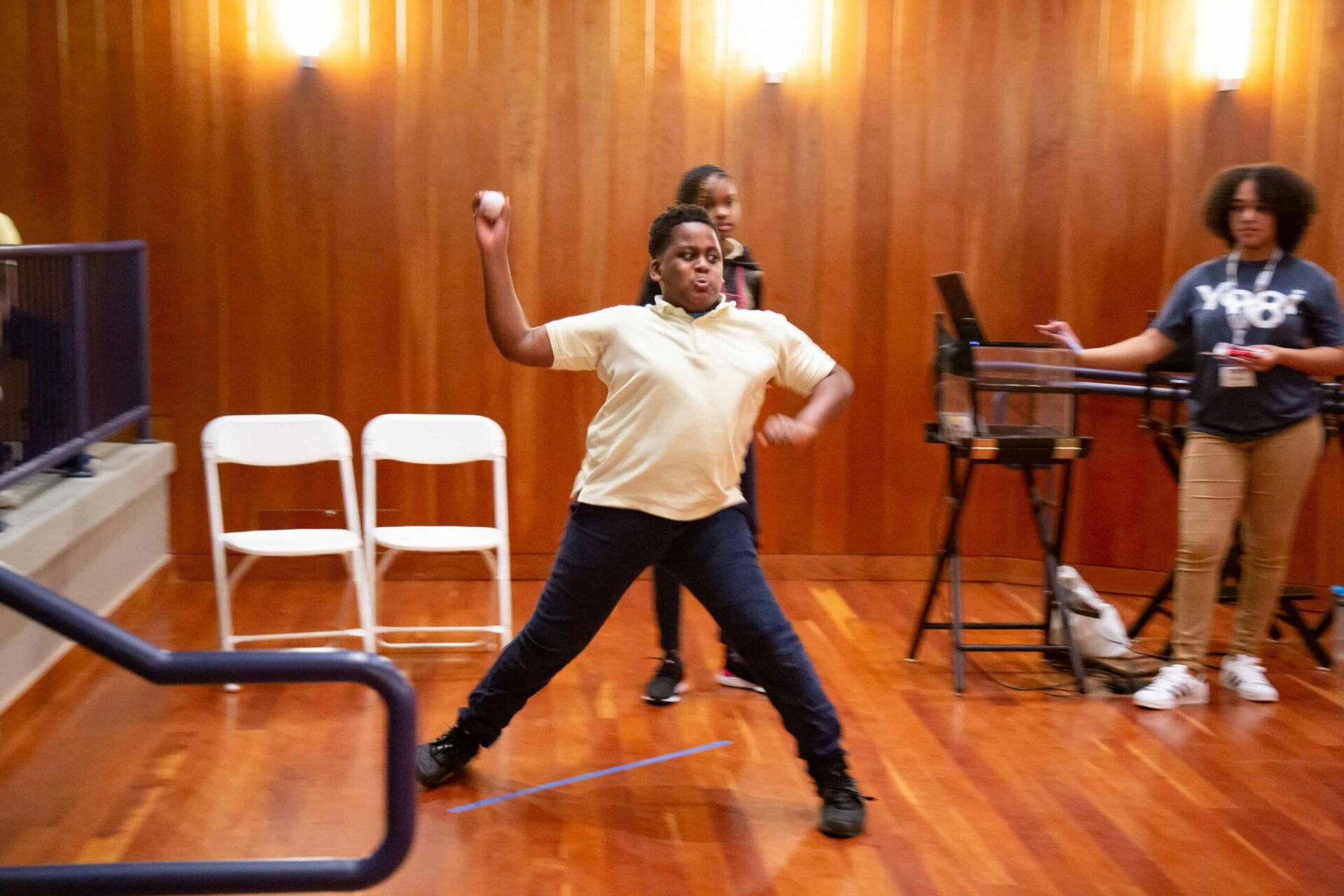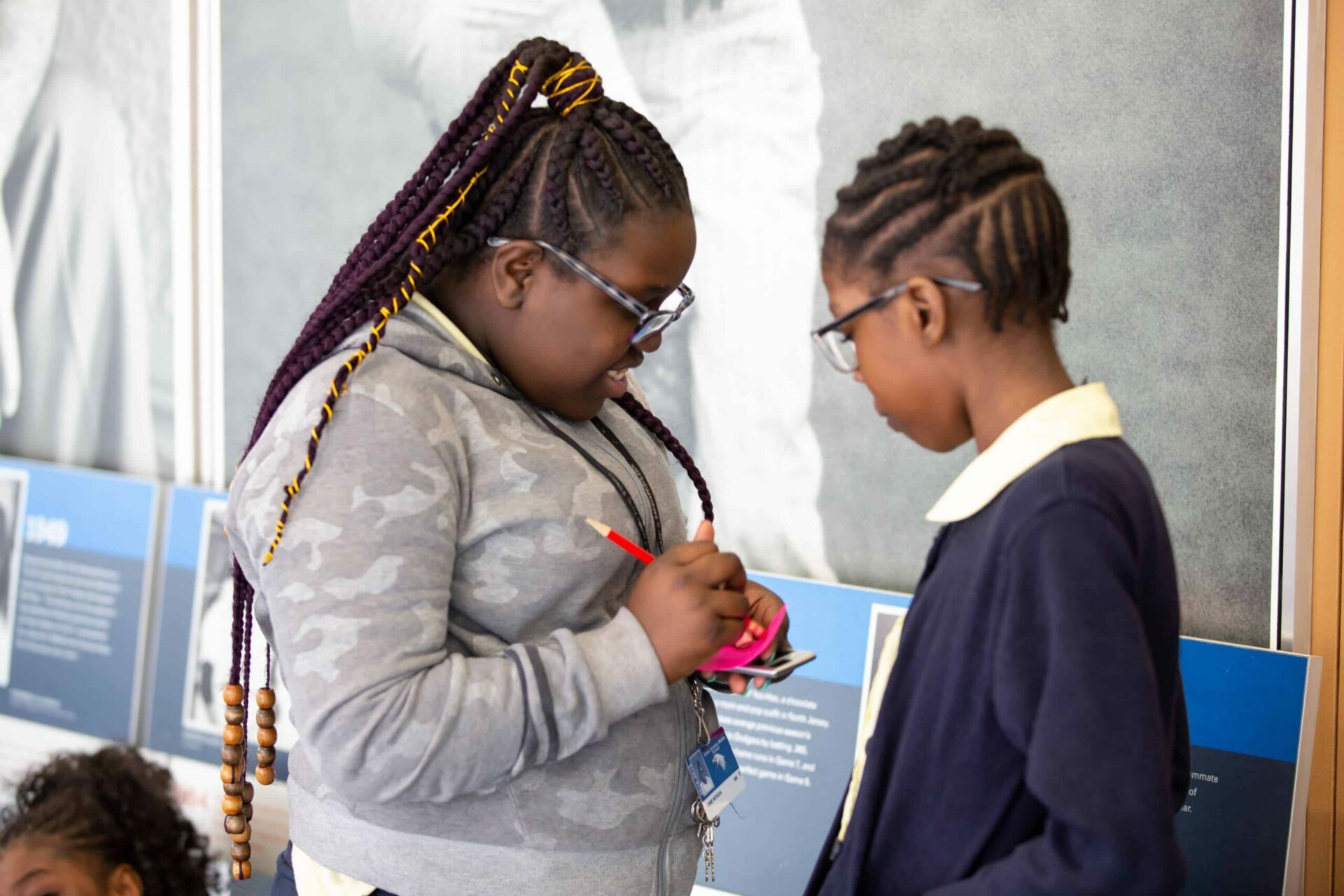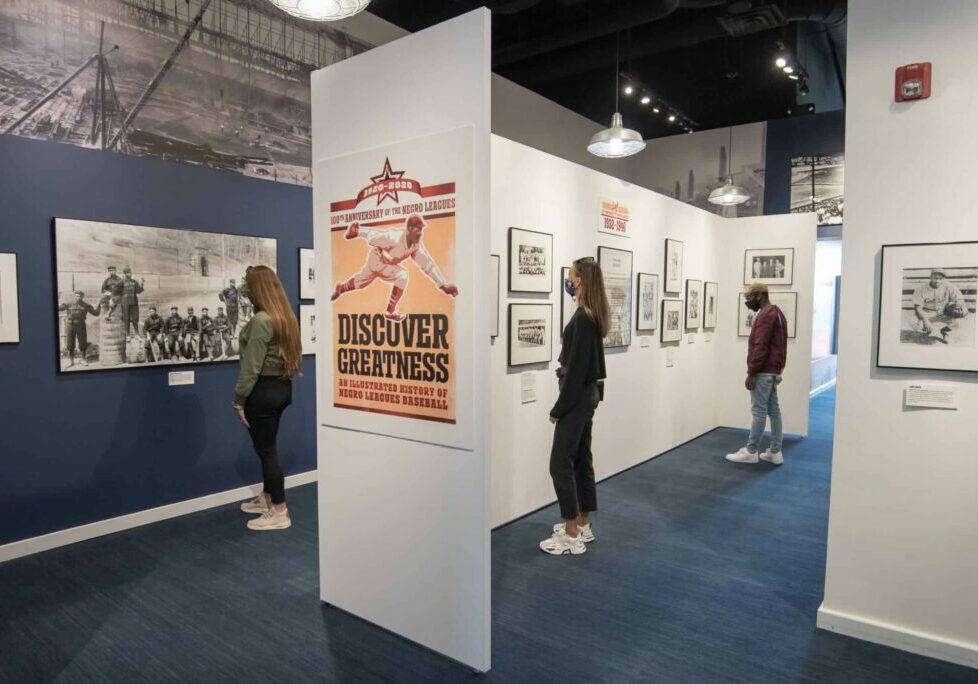Education at the Yogi Berra Museum & Learning Center
By Eve Schaenen
How does a museum located in Little Falls, New Jersey dedicated to a living icon—a figure who was fully involved in the visitor experience for nearly 20 years—remain engaging and relevant after that icon passes away? That was the question facing the Yogi Berra Museum & Learning Center after Yogi Berra’s death in September of 2015. And how does that same museum continue to fulfill its mission when shuttered by a global pandemic? That was the question for March of 2020.
The answer to both questions turns out to be the same: Lean hard into education.
Determining a course of action after Yogi’s death in 2015 wasn’t difficult. When the museum was built in 1998, Yogi and his wife Carmen meant for it to be primarily a place for young people to learn. Hence the name: Yogi Berra Museum & Learning Center. Even as the museum became known for its one-of-a-kind collection of sports memorabilia and special events featuring Yogi’s famous athlete friends, the House that Yogi Built, as far as Yogi was concerned, was always, in his words, “about the kids.”
Yogi’s strong interest in education came from personal experience. Growing up a child of immigrants on “The Hill”, an Italian working-class neighborhood in St. Louis, the future Hall of Famer had been forced to leave school after the eighth grade to help support his family. While his abbreviated school career didn’t prevent him from leaving an indelible mark on American culture—Yogi is widely considered among the most quoted Americans in history—he wanted the institution bearing his name to offer educational opportunities to young people, opportunities he hadn’t enjoyed himself.

Students reenact an iconic baseball moment.
Fortunately, the game of baseball, and sports in general, provide a perfect vehicle for all kinds of learning. The museum’s leadership understood that nearly every young person has some connection to sports—often positive, almost never indifferent. Yogi’s legacy as a sports icon offers easily accessible entries into important academic content across numerous disciplines. Beyond the game itself, Yogi’s story reaches past the playing field and tells of a uniquely American journey that illustrates the values driving the museum’s mission: perseverance, respect, strength of character and purpose. And while Yogi’s life and career are anchored in the 20th century, the museum connects his history to topical events of today.
Sports permeate so many areas of our current culture, with professional athletes using their platforms to address everything from fashion and entertainment to heated political and social issues. The museum’s education programs don’t shy away from exploring the ways sports often drive change; change that can have an impact on the daily experiences of the young people served. The goal is to provide students with a safe space for brave talk. And for the kids to learn, move their bodies and have fun while they’re at it.
Drawing on every aspect of Yogi’s biography, the museum spent the years after his death (leading up to the unprecedented events of 2020) developing and implementing an array of standards-aligned, in-person education experiences that support and extend classroom learning in unique ways. One of the first immersive trips the museum created for visiting students focuses on STEM; specifically, the physics of baseball, and how mathematics and statistics permeate our national pastime.
Playing with the museum’s interactive video installation, PITCH!, and radar guns elsewhere in the museum, young people experience in their own bodies concepts of momentum and the kinetic transfer of energy as they throw real balls in real time. They calculate averages of their pitching speeds and measure their pitching strides as a percentage of their height, as professional players do.
Importantly the STEM program—like all of the museum’s learning experiences—encourages kids to consider values-based aspects of sports as well. For example, an examination of batting averages using baseball cards invites consideration of perseverance and grit in the face of failure, as the young people discover that even the best hitters “fail” roughly 70% of the time.
“The museum staff really connected science and math to sports in a way that was so meaningful and fun for kids,” wrote Elena Larranaga, lead science teacher from the Dr. William H. Horton School of Arts and Technology in Newark.
Poetry, spoken word and Yogi-isms
The enthusiastic response to the museum’s STEM program led to the development of three more learning experiences, all of which have proven compelling for educators and students alike. A language arts immersion builds on Yogi’s famous playfulness with language. Yogi remains the most quoted American sports figure of all time, well known for his Yogi-isms such as “It ain’t over til it’s over,” and “When you come to a fork in the road, take it.”
Leveraging this unique aspect of his legacy, the museum created a Poetry & Spoken Word program that has young people unpacking their own identities and writing poetry that draws from their individual experiences. In addition to using Yogi-isms for inspiration, they examine word choice and imagery in the works of artists like Kendrick Lamar, Jay-Z, Maya Angelou and Amanda Gorman. After drafting pieces, students can perform their work for their teachers and peers in the museum’s stadium-style theater.
Nejuwah Singley, eighth grade spoken word teacher from Sussex Avenue School in Newark wrote, “Every kid left with two written pieces—a spoken word piece and a haiku. Furthermore, they were able to share a small portion of their lives with their peers, so we learned to be more accepting and tolerant of each other—and we had a fantastic time!”

The friendship of Yogi Berra and Jackie Robinson
Another program focuses less on Yogi Berra’s status as a Hall of Fame baseball player and highlights his qualities as a Hall of Fame person. Students learn about Yogi’s unwavering respect for others, focusing on his unique and lifelong friendship with barrier-breaker Jackie Robinson. A slideshow documents the contrasting upbringings of these two iconic New York ballplayers, who remained respectful rivals on the field throughout their overlapping careers.
Students have the opportunity to practice observation and critical thinking skills as they study the well-known but controversial call of Jackie stealing home on Yogi during Game 1 of the 1955 World Series, Yankees vs. Dodgers. The umpire called Jackie “Safe!” but Yogi objected that Robinson was “Out!”—continuing to do so throughout his life. The Dodgers went on to win the World Series in Game 7. (When President Barack Obama asked Yogi about the iconic moment, Yogi immediately interjected: “Mr. President, he was out!”)
Through still photography and video, students examine Jackie’s run and slide, consider the angles from which the umpire made his questionable call, then reenact the historic play themselves with costumes and props as they debate their positions.
“My fifth graders were super engaged in the program about the Yogi Berra/Jackie Robinson friendship,” wrote Dana Falcicchio, fifth grade teacher at Academy of Our Lady of Mt. Carmel in Tenafly. “It asked them to talk about history in a different way. The activities were fun and interactive, and the educators encouraged all the students to be involved and ask questions. We had so much fun!”
Studying the Negro Leagues
The most recent education program was developed in recognition of a milestone in baseball and American history: the 100th anniversary of the game’s Negro Leagues. In honor of this centennial, the museum mounted Discover Greatness: An Illustrated History of Negro Leagues Baseball, on loan from the Negro Leagues Baseball Museum in Kansas City. The exhibit showcases 90 framed photographs and artifacts illustrating the rich history of Black baseball from the late 1800s to the 1960s. An augmented reality app allows images to be enhanced and viewed in color, bringing these often forgotten athletes to vivid life.
The accompanying education program explores the complex history and struggles of Black players in our national pastime, illuminating historical concepts such as Jim Crow and the Great Migration, as well as larger, ongoing issues of systemic racism and its impact on communities of color.
Given the national reckoning around race and racism over the past year, the program has provided an organic path into challenging conversations for students from all different backgrounds.
Yvonne Copprue-McLeod, sixth grade social studies teacher from the Harriet Tubman School in Newark wrote, “The History of the Negro Leagues program is incredible! My sixth grade students and I … were able to experience personal accounts of how our Black and brown unsung heroes greatly influenced America’s favorite pastime, baseball. With great pride, we listened and discussed their inspirational anecdotes of courage, determination, and fortitude … The students were able to participate and have meaningful discussions about many issues that we still face today like social justice and inclusion. I have seen this exhibit three times and each time I have walked away with something new!”

Reinventing the museum during a pandemic
This story of in-person education programs at the Yogi Berra Museum & Learning Center might have continued as a straightforward narrative of growth and increased impact—attendance doubled each year in the first three years of the museum’s reinvigorated outreach to schools—but then came the unprecedented events of 2020.
Covid-19 forced the museum to shut its doors to the public, including the thousands of students who would have taken part in field trips. Once again, the institution had to reinvent itself as it had done after Yogi Berra’s passing. More precisely, it had to recommit to Yogi’s original intention of making his museum “all about the kids.” Education should and would remain the key to sustaining his legacy. But how to do that when the world was sheltering in place?
At a time when students couldn’t come to the museum, the museum decided to go to the students. Virtually.
Within weeks of shuttering the facility, the museum’s education team had translated all its programs to remote platforms. Kids pitching softballs in the museum atrium to demonstrate the kinetic transfer of energy became kids pitching sock balls and stuffed animals across their bedrooms on Zoom. The Discover Greatness exhibition was remounted online so that conversations about race could continue, conversations that proved more important than ever in the months following the murder of George Floyd.
And the values that run through all the museum’s programs—perseverance, grit, respect and teamwork—were on full display daily in the dedication of frontline workers worldwide, including the educators who took it upon themselves to make the virtual field trips happen. Moreover, the fact that the museum’s programs went remote meant that access for “visiting” students was no longer limited by geography. Students from across the country, including Atlanta, Houston, Lafayette, Louisiana and Yogi’s hometown of St. Louis, were able to learn, play and be inspired by Yogi’s story during the virtual field trips. Student attendance tripled in 2020.
Professional development for educators
The pandemic didn’t get in the way of the museum’s commitment to teacher professional development either. A comprehensive set of sports-based lesson plans addressing such topics as immigration, race, women in sports and financial literacy provide the core of the museum’s online curriculum called In Search of a Level Playing Field. The material is free and accessible through the museum’s website and includes all the pedagogical tools for a deeper dive into these timely subjects, such as essential questions, key terms, primary source material, videos, activities, games, handouts and more.
Educators looking to extend classroom learning for themselves, or for a substitute teacher, joined the workshops remotely. According to Paul Maloney, social studies teacher from Cranford: “The material on the website with the lesson plans can be of tremendous aid to any classroom teacher. I especially like how you’re going to keep applying the theme to current issues in the news such as Black Lives Matter, Colin Kaepernick and other related topics. The presentation and plans were truly in depth and had an understanding that talking about race in the classroom is hard.”
And now? What appears clear is that education at the Yogi Berra Museum & Learning Center will remain the driving force behind the institution’s work. What is also clear is that the creative flexibility demanded by the pandemic will shape the future of this work. So while it is with great joy that the museum has recently welcomed students and educators back into the building again, handing them balls to throw and iPads to view forgotten heroes in living color, it is also true that the comprehensive remote programming that has been on offer is here to stay. And that through the advancements of technology, the legacy of the great Yogi Berra, as well as the values that made him a national treasure, will reach young people near and far, and farther still.
Schedule a visit or a remote program
To learn more about the Yogi Berra Museum & Learning Center or to plan a visit, in person or virtually, visit yogiberramuseum.org.
